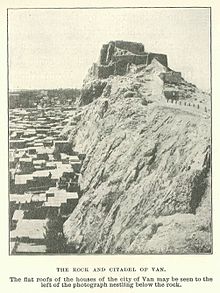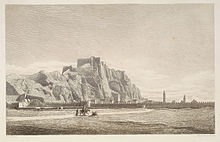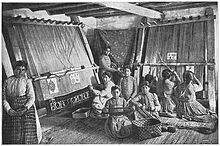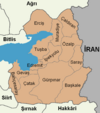Van (Turkey)
| Van | ||||
|
||||
 Akdamar Island with the "Church of the Holy Cross". |
||||
| Basic data | ||||
|---|---|---|---|---|
| Province (il) : | Van | |||
| Coordinates : | 38 ° 30 ' N , 43 ° 23' E | |||
| Height : | 1750 m | |||
| Residents : | 353,419 (2011) | |||
| Telephone code : | (+90) 432 | |||
| Postal code : | 65,000 | |||
| License plate : | 65 | |||
| Structure and administration (as of 2019) | ||||
| Mayor : | Bedia Özgökçe Ertan ( HDP ) | |||
| Website: | ||||
| Van County | ||||
| Residents : | 445,915 (2011) | |||
| Surface: | 1,938 km² | |||
| Population density : | 230 inhabitants per km² | |||
Van ( Kurdish Wan , Armenian Վան Wan , Urartian Tuschpa , Syrian perhaps Arzaškun ) is the capital of the Turkish province of Van of the same name .
Van lies in the region Ostanatolien the eastern shore of Lake Van near the Iranian -türkischen limit. Opposite Van on the west bank of the lake is the town of Tatvan , which is connected to Van by a ferry .
Demographics
| year | number | year | number | year | number |
|---|---|---|---|---|---|
| 1889 | 35,000 | 1950 | 15,664 | 1980 | 92,801 |
| 1927 | 6,980 | 1955 | 17,254 | 1985 | 110,655 |
| 1935 | 9,562 | 1960 | 22,045 | 1990 | 155,623 |
| 1940 | 11,785 | 1965 | 51,451 | 2000 | 284.464 |
| 1944 | 12,000 | 1970 | 46,751 | 2010 | 367,419 |
| 1945 | 14,266 | 1975 | 65,665 | 2011 | 353.419 |
history
Ancient and Middle Ages
The settlement mound Tilkitepe ( Fox Hill ) near the city of Van shows that the area was built around 5000 BC. Was already settled.
The history of the city of Van as a settlement at the present location goes back almost 3000 years. Under the name Tušpa (the town center around the Van Fortress), Van was known from the 9th century BC. Chr. The capital of the Urartian kingdom . After wars against the Assyrians , Cimmerians and Scythians , the kingdom of Urartu fell in the 6th century BC. Chr. Under.
From then on, Van shared the history of Armenia with no reported local peculiarities until the end of the 8th century AD. The Urartian culture was forgotten, their graves were now considered the work of gigantic heroes. According to Thomas Artsruni, the mythical Armenian King Artaxias is said to have lived in a rock cave from which he could overlook Lake Van, probably one of such Urataean tombs. Saint Gregorius von Narek (approx. 951-1003), a well-known mystic from the Kingdom of Vaspurakan , also used such caves for prayer. Perhaps he even wrote the famous "Book of Lamentations" here.
After the retreat of the Muslim Arabs in the 8th century, an independent Armenian kingdom was re-established. Under the Armenian king, there were Armenian principalities such as that of the Artsruni dynasty in the area of Lake Van, which, as the kingdom of Vaspurakan, broke away from the supremacy of the Armenian king at the beginning of the 9th century. Vaspurakan had no fixed capital, the king moved from city to city. Van was one of those cities too. In 1021 Vaspurakan was annexed by Byzantium.
In the 11th century, the Seljuks invaded Anatolia and took control of Van. From the early 12th to the early 13th century the city belonged to the principality of the Ahlat Shahs , after which it fell to the Ayyubids . In 1240 the Mongols conquered the area around Van. In the 14th century Van was part of the Karakoyunlu and later the Timurid Empire . In the 15th century, Van got into another conflict between the empires of the Ottomans and the Safavids . In 1502 Van was conquered by the Safavids.
Van in Ottoman times
Only 13 years later, the Ottomans conquered the city and lost it again to the Safavids in 1520. On August 25, 1548, the Ottomans were finally able to conquer the city. Van first became a sanjak in the province of Erzurum and became an independent Ottoman Eyâlet around 1570 . In 1875 it finally became the capital of the vilayets Van , which at that time was still largely Armenian and Assyrian populations and was one of the six Armenian vilayets . In 1894 there were massacres of the Christian civilian population under the Ottoman Sultan Abdülhamid II. The Diyarbakir massacres in 1895 also spread to Van. As a result, the non-Muslim population was strongly decimated for the first time.
In the second year of the First World War , therefore, in 1915 Armenian supported fedayeen in defense of van , the armed forces of the Russian Empire , by the Caucasus revenues coming and with the help of Van on 20 May 1915th On April 7, 1915, the city was completely surrounded by 10,000 Armenian rebels. The Muslim population tried to flee Van. The inhabitants of the villages in the area Vans, Derebey, Hakis, Zorova, Hıdır, Göllü, Şeyhane and Şeyhkara fled to the central village of Zeve. A little later, Zeve was stormed by Armenian rebels, killing 2,000 Muslims. The Ottoman army succeeded in retaking the city in August 1915, but lost it again to the Russians in September of the same year.
In the course of the October Revolution , Russia withdrew from Asia Minor and so Van and other cities came back under Ottoman rule. The Ottoman Empire lost the First World War and so the Treaty of Sèvres provided for the cession of large parts of the eastern territory of the empire to an independent Armenia. The Turkish national movement under Kemal Pascha, later Kemal Ataturk, opposed this treaty . Their troops recaptured Van from the Armenians in the Turkish War of Liberation in 1920. This resulted in the murder and expulsion of the Armenian population, which explains, among other things, the drastic decimation of the population from 1889 to 1927. The current border between the Republic of Turkey and Armenia was laid down under international law in the treaties of Alexandropol / Gümrü 1920 and Kars 1921. However, the Treaty of Kars is still not recognized by the Armenian side.
The old town of Van suffered severe damage during the fighting of 1915 and was abandoned after the war. The new city center was built a few kilometers east of the Vans fortress in the area of the so-called garden city, the modern former suburb of Van.
Recent events
In 1950, Van was damaged by an earthquake. On October 23, 2011, the city was shaken again by a violent earthquake that killed around 1000 people in the region.
The Interior Ministry of Turkey announced on November 17, 2016 that, among other things, the mayor of the city of Van had been deposed. The city will now be placed under compulsory administration.
traffic
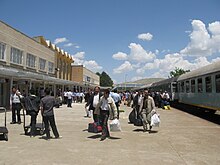
Van is located on the European route E99, which connects Turkey with Azerbaijan . A railway ferry connects the city with Tatvan on the west bank of Lake Van and a railway line leads to Iran to Tehran . Turkish Airlines flies to Ferit Melen Airport in Van from Istanbul and Ankara .
economy
Van's economic structure is traditionally based on agriculture. There are companies in the meat and fish industry, the production of woolen yarn and other companies such as flour and feed mills, a dairy and a sugar factory. The wood industry, plastics industry, a cement factory and leather and shoe factories create jobs in the industrial sector.
tourism
From a tourist point of view, the castle of Van ( Van kalesi ) by the lake is worth mentioning , in which several Urartian cuneiform inscriptions from the time of Sarduri II can be seen, as well as the archaeological museum.
In the vicinity is the island of Akdamar with an Armenian church from the 10th century . In 2007 the church was restored and opened as a cultural monument. On September 19, 2010, the church was consecrated again with the first service in 95 years. The church dome got a cross in 2010. Also worth seeing are the ruins of the Urartian fortress Šarduriḫinili and the fortress of Hoşap , as well as bathing spots on the shores of Lake Van.
Hrant Dink explained that Van could have become the Paris of the East had it not been for the Armenian genocide .
Climate table
| Van, Tuşba | ||||||||||||||||||||||||||||||||||||||||||||||||
|---|---|---|---|---|---|---|---|---|---|---|---|---|---|---|---|---|---|---|---|---|---|---|---|---|---|---|---|---|---|---|---|---|---|---|---|---|---|---|---|---|---|---|---|---|---|---|---|---|
| Climate diagram | ||||||||||||||||||||||||||||||||||||||||||||||||
| ||||||||||||||||||||||||||||||||||||||||||||||||
|
Monthly average temperatures and rainfall for Van, Tuşba
|
||||||||||||||||||||||||||||||||||||||||||||||||||||||||||||||||||||||||||||||||||||||||||||||||||||||||||||||||||||||||||||||||||||||||||||||||||||||||||||||||||||||||||||||||||||
gallery
Town twinning
Project partnership:
- Germany - Karlsruhe
Personalities
- Gregor von Narek (951-1003), Armenian mystic
- Mkrtitsch Chrimjan (1820–1907), Armenian church leader
- Harutiun Jangülian (1855–1915), Armenian politician and genocide victim
- Panos Terlemezyan (1865–1941), Armenian-Soviet painter
- Ferit Melen (1906–1988), Turkish politician and former Prime Minister of Turkey
- Ruhi Su (1912–1985), Turkish opera and folk singer
literature
- Richard G. Hovannisian: Armenian Van / Vaspurakan . Costa Mesa 2001. ISBN 1-56859-130-6
- HF Russell, Shalmanese's campaign to Urartu in 856 BC and the historical geography of Eastern Anatolia according to the Assyrian sources. Anatolian Studies 34, 1984, 171-201.
- Justin McCarthy, Esat Arslan, Cemalettin Taşkıran, Ömer Turan: The Armenian rebellion at Van . 1st edition. The University of Utah Press, Salt Lake City 2006, ISBN 978-0-87480-870-4 , pp. 296 (English, 11 cards).
Web links
Individual evidence
- ↑ a b Turkish Institute for Statistics ( Memento of November 13, 2012 in the Internet Archive ), accessed August 16, 2012
- ↑ a b XVIII. yy SONRASI VAN. (No longer available online.) In: http://www.van.gov.tr/ . Gouvernemet Vans, p. 1 , archived from the original on April 29, 2008 ; Retrieved March 28, 2009 (Turkish). Info: The archive link was inserted automatically and has not yet been checked. Please check the original and archive link according to the instructions and then remove this notice.
- ↑ NÜFUS. (No longer available online.) In: http://www.van.gov.tr/ . Gouvernemet Vans, p. 1 , archived from the original on March 1, 2009 ; Retrieved March 28, 2009 (Turkish). Info: The archive link was inserted automatically and has not yet been checked. Please check the original and archive link according to the instructions and then remove this notice.
- ↑ James R. Russell, review by Robert W. Thomson (ed.), Thomas Artsruni, History of the House of the Artsrunik. Middle East Journal 43/2, 1989, 313 f.
- ↑ Recommendation 7511 on stability and security in the South Caucasus. (PDF) (No longer available online.) In: http://www.bundestag.de/ . German Bundestag , p. 4 , archived from the original on June 19, 2008 ; accessed on March 28, 2009 (German). Info: The archive link was inserted automatically and has not yet been checked. Please check the original and archive link according to the instructions and then remove this notice.
- ↑ Peter Seiffert: Provincial capital Van: Many dead in earthquakes in the east of Turkey. In: Focus Online . October 23, 2011, accessed October 14, 2018 .
- ^ Government removes four mayors. Tagesschau, November 17, 2016, accessed on November 25, 2016 .
- ^ Church on Akdamar free for pilgrims . In: TURKISHPRESS | German-Turkish news about Turkey and the Turks . March 25, 2010 ( turkishpress.de [accessed August 20, 2018]). Church on Akdamar free for pilgrims ( Memento of the original from August 20, 2018 in the Internet Archive ) Info: The archive link has been inserted automatically and has not yet been checked. Please check the original and archive link according to the instructions and then remove this notice.
- ↑ Akdamar Church bears a holy cross . In: TURKISHPRESS | German-Turkish news about Turkey and the Turks . September 18, 2012 ( turkishpress.de [accessed August 20, 2018]). Akdamar Church bears a holy cross ( Memento of the original from August 20, 2018 in the Internet Archive ) Info: The archive link has been inserted automatically and has not yet been checked. Please check the original and archive link according to the instructions and then remove this notice.
- ^ Cem Özdemir : Turkey and Armenia: Peacemakers in sight. October 11, 2005, accessed June 1, 2013 .


